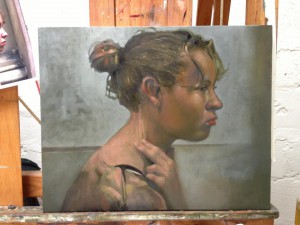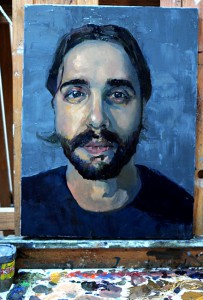Isaac Levitan
ISAAC LEVITAN – Russian Tonalist
–

Herman Herzog
American Tonalist painter
November 15, 1832 – February 6, 1932
99 Years old when he died!
Description of the Tonalist Painting Style and Technique
Ralph Blakelock
American Tonalism is rooted in the French Barbizon movement, which emphasized atmosphere and shadow. The Tonalist style employs a distinctive technique by the use of color’s middle values as opposed to stronger contrast and high chroma. Resulting in a understated and compelling overall effect. The tonalist subject matter is never entirely apparent; their is no effort to communicate a message or narrate a story. Instead of relating a story, each sensitively chosen color, composition, and line is arranged to create an intriguing visual poem.
The interiors of tonalist paintings are generally elegant and sparsely decorated, tonally uniform, simplified and indistinct; the figures are usually presented alone in silent contemplation. Landscapes are typically luscious and luminous with evocative atmospheric effects featuring misty backgrounds illuminated by moonlight. Tonalists painters were drawn to both the natural and spiritual realms. They sought to awaken the viewers consciousness by shrouding the subject in a misty indistinct veil of emotionalism. The palette is minimal, characterized by warm hues of brown, soft greens, gauzy yellows and muted grays. Preferred themes were evocative moonlight nights and poetic, vaporous landscapes. Tonalist painters seemed to favored unconscious states and psychological experiences over reality.
-Taken from historyofpainters.com
Working on a new body of oil paintings – embracing my lineage as a realist painter, throwing myself once again into a rich, deep tradition which hit great heights. Long live the Barbizon and Hudson Valley painters school of thought – enriching my life as a monkey and sentient being! Values of mixed orange and tertiary greens – ethers, ground, vapor, warm greys and cool hues- have shown me the light.
There is a feeling I get when in front of an Impressionist painting – a feeling of honesty and love. I know they were striving for ‘realism’ and Degas or one of them, possibly Gauguin wanted to call it a realist movement – but the subjugation of light and life filtered in tot the work done daily, and the build up of underpainting stopped. It became a direct approach to paint, in which I am totally engaged in. I now build up an under drawing, with little care to line quality, or tonality – just to fit the work on the page, to see if it is with my weeks time. Yesterday I found myself in front of a horse and buggy, a decent picture, with some perspective, people, trees,a horse or two actually, and rider. I challenged myself to put this down in under an hour, on a 18/24 canvas – but found after an hour or so – it was not worth doing. It is a trite picture, and I am overly concerned with drawing it ‘right’, which is taking me out of the spirit of painting.
In turn I will embark on a less traditional, more bucolic scene. I am excited to put it down the way Inness did, the way Church saw the world – with less of a church bend.
I sometimes stop at a certain point within the process of composing a new work, and judge the theme, the intent and scheme I am pushing – only to know I do not want to pursue this – I want to focus on what brought me to choose the motif, and go the opposite route. By wiping down a days work, it is cathartic, and nothing is really lost. ALl the composing, paint and energy is still there, and will guide the next, hopefully better work of art. I need to create new things, and arrive at levels within the composition in which it needs to be left – or the original intention gets over sighted by trying to ‘finish’, or ‘wow!’ yourself. I am learning to know when to stop, to rely on my visions. When I am clear I see what needs to be done, and some days are for wiping down the canvas, a whole days work. Tomorrow is a new day, and if the elements are balanced, the work will most definitely – be sublime.
Painter of the day: GEORGE BELLOWS
Blue Snow, The Battery by George Bellows (1910), Oil on Canvas
Died age 42. Enjoyed summering in Woodstock.
This painting is a rare view of Battery Park NYC.
Unlike his social realism, this one dives into a more traditional approach, a nod to the Impressionists. His work moves me in many ways.
I paint, but know how to draw. To have given it up for color, composition and paint technique – I use it only to indicate where dark darks and lights are,where the composition should live. I draw in my sketchbook,for assignments and story boards, but rarely to finish. Today in class I lectured about perception and maintaining a clear mindset to overcome the materials. Not let the school dictate your course, and to use the resources available through the past masters (museums, books, peers). We drew from the model, first doing 1 minute poses, then up to 5. All in charcoal on drawing paper – I circle the room and call out ideas on how the background dictates what is happening in the figure. The model had a very bad attitude, and I later found out it was due to the kids sitting on the stand. She was also rolling her eyes at kids, and had a generally uneasy way about her. The kids, regardless of the models shitty attitude, made the best of it. I am starting to see real progress, and the marks are beginning to take on a more random, interesting pattern. The background is so important in drawing the figure, as it is in painting. Beauty is in the eye of the artist. It is up to us to see the beauty and capture what it is, not let it move away. Something that appears beautiful can seem ugly a moment later – and to recall and memorize what it is that attracted you in the first place is quintessential to a strong outcome. 
This painting is what I’m working on this week. I also have a small landscape going. I have been studying faces,animals and skulls – neglecting my landscape lineage. I am coming back to the pleine air experience!
I can’t wait to get absorbed in nature – in the mixture of green and umber. In breathing air and working without stopping.
I always love revealing the art of Corot, Degas, Picasso, Sisley, Monet, Manet, etc. to my students! It is thrilling to see how the styles influence each other, and make for a nice morning.
‘Horse Head’, 18/36, Oil on Canvas, ©2013 by Gavin Spielman

also check out my video tutorial on how to mix flesh tone
http://www.youtube.com/watch?v=udf__LzefNY